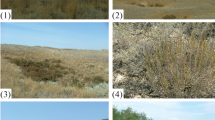Summary
In two samples taken by different collectors a wet new constructed office-building situated in meadowland the author has found seven mostly mould-eating mite-species partly in masses, among themNeoseiulus barkeri, till now not known in new buildings. The mite-trouble vanished after the edifice had been dried up.
Similar content being viewed by others
Literaturverzeichnis
Chant, D. A., 1959: Phytoseiid mites (Acarina: Phytoseiidae). Canad. Ent.,41, Suppl.12, 1–165.
Cooreman, J., 1962: Invasion massive des habitations parHaemolaelaps casalis (BERLESE) (Acari, Mesostigmata). Bull. Ann. Soc. Roy. Ent. Belg.,98, 388–391.
Dosse, G., 1956: Über die Bedeutung der Raubmilben innerhalb der Spinnmilbenbiozönose auf Apfel. Mitt. Biol. Bundesanst. f. Land- u. Forstw. Berlin-Dahlem,85, 40–44.
Dosse, G., 1958: Die Spermathecae, ein zusätzliches Bestimmungsmerkmal bei Raubmilben (Acar., Phytoseiidae). Pflanzenschutzber.,20, 1–11.
Hughes, A. M., 1961: The mites of stored food. Tech. Bull. Minist. Agric. Fish. Food, No. 9, London, 1–287
Karg, W., 1965: Larvalsystematische und phylogenetische Untersuchung sowie Revision des Systems der Gamasina LEACH, 1815 (Acarina, Parasitiformes). Mitt. Zool. Mus. Berlin41, 193–340.
Nesbitt, H. H. J., 1951: A taxonomic study of the Phytoseiinae (Family Laelaptidae) predaceous upon Tetranychidae of economic importance. Zool. Verh.,12, 1–64.
Přívora, M. &Samšiňák, K., 1958: Milben als Menschenplagen Z. f. Parasitenkunde,18, 257–269.
Rack, G., 1963:Kleemannia (Acarina, Ameroseiidae), ein neuer Wohnungslästling. Ent. Mitt. Zool. Staatsinst. Zool. Mus. Hamburg No. 44, 2, 407–413.
Rack, G., 1964: Über das Auftreten der MilbeKleemannia plumigera Oudemans, 1930 in Neubauten. Mit besonderer Berücksichtigung des Milbenbefalls im neuen Rathaus zu Flensburg. Prakt. Schädlingsbek.,16, 125–127.
Rack, G., 1965: Milben in Wohnungen. Ibid.,17, 69–72.
Rack, G., 1968: Milben als Hausungeziefer u. Vorratsschädlinge in Nordwestdeutschland. Ent. Mitt. Staatsinst. Zool. Mus. Hamburg No. 62,3, 249–267.
Zacher, F., 1930: Beobachtungen und Erfahrungen auf dem Gebiete der Vorratsschädlinge und ihrer Bekämpfung. Mitt. Ges. Vorratsschutz,6, 42–43.
Rights and permissions
About this article
Cite this article
Rack, G. Massenvorkommen vonNeoseiulus barkeri HUGHES, 1948 (Acarina, Phytoseiidae) und sechs weiterer Milbenarten in einem Neubau. Anzeiger für Schädlingskunde 42, 184–186 (1969). https://doi.org/10.1007/BF02330196
Published:
Issue Date:
DOI: https://doi.org/10.1007/BF02330196




